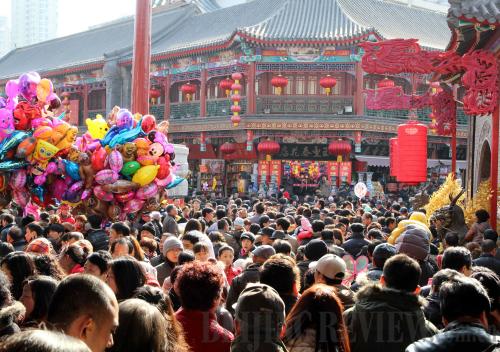|
 |
|
LARGE CROWD: Tourists stroll on the Tianjin Ancient Cultural Street on February 15 (WANG YUELING) |
After holding their wedding ceremony in Zunyi, Guizhou Province, Tian Yun, a bond trader who works at a Shanghai-based securities company returned to Kaifeng, Henan Province, with her husband during the Spring Festival holiday (February 9-15). In her hometown, relatives and folks prepared a party to celebrate.
"My mother booked the banquet tables three months ahead. Since banquet booking is always popular during the Spring Festival, bookings for a larger gathering like a wedding reception are done as early as July," said Tian.
In Kaifeng, a city along the Yellow River with a population of nearly 5 million, banquet prices increase by 20 percent during the Spring Festival. "A table at medium-priced restaurants would be priced at roughly 600 yuan ($96). We ordered 10 banquet tables. Counting other expenses, the party cost us about 10,000 yuan ($1,603)."
The Chinese way of life is changing. Today, restaurants seem to be the most appropriate place for a family reunion while the older generation used to treat relatives and friends at home with traditional Chinese cuisine like braised pork.
From February 9 to 15, the sales revenue of major retail and catering enterprises in China rose 14.7 percent to 539 billion yuan ($86.4 billion) compared to the same period last year, according to the Ministry of Commerce (MOFCOM). Revenues of major catering businesses in Shanghai and Tianjin municipalities and Hubei and Henan provinces jumped 6 percent, 18.5 percent, 15.5 percent and 5.3 percent respectively during the holiday.
This consumption confidence is an indication that buoyant domestic demand is propping up the Chinese economy.
And the spending spree during the holiday was not confined to the domestic market. Against the backdrop of stagnating global consumption, China's Spring Festival has evolved into a bellwether for global economic growth.
Shopping binge
While daily necessities witnessed stable growth, goods traditionally consumed during the Spring Festival took the lion's share of the consumer market.
Sales revenue for food and beverages by major retail enterprises shot up by 9.8 percent and 11.2 percent respectively, according to the MOFCOM.
Special purchases for the Spring Festival in Guangxi Zhuang Autonomous Region and Hunan Province both went up by 20 percent, according to statistics from local supermarkets.
Coupled with the Valentine's Day, this Spring Festival has been a boon for jewelry retailers. With people busy tying the knot and buying jewelry to demonstrate love, sales revenue of gold, silver and jewelry by major retailers experienced a year-on-year increase of 38.1 percent, according to the MOFCOM. Gold, silver and jewelry stores in Beijing, like Caibai, Gongmei and Guohua, realized cumulative sales revenue of 630 million yuan ($101 million).
Big promotions for winter dresses and the unveiling of spring arrivals in shopping malls attracted throngs of holiday shoppers, with sales revenue rising by 6.3 percent and 7.5 percent respectively.
More and more people are longing for spending the holidays in a healthy and leisurely way. Besides traditional folk activities like temple fairs, fashionable ways to spend the holidays—like skiing, visiting hot springs and flower viewing—also grew in popularity.
In Beijing, Ditan Park Temple Fair alone received more than 1.02 million visitors during the festival, up 9.3 percent compared with the same period last year.
Visitors at ski resorts in Chongli, Hebei Province, registered 20,000 during the holiday. The spectacular sea of 300,000 tulip blossoms in Yuntai Park, Guangzhou, as well as Fengxiang's colorful clay sculptures and shadow puppetry, also captured numerous visitors.
| 